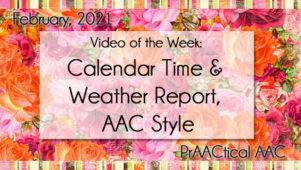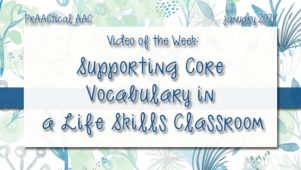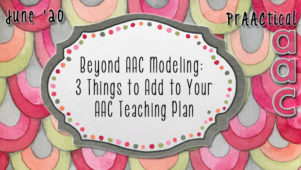Beyond “Train and Hope” 5 Ways to Support Carryover of Skills by AAC Learners

With her SLP, Marissa conjugates verbs and includes function words to make the sentence grammatically correct (e.g., “She is going home with me”). With others, she tends to use her AAC more telegraphically (e.g., “She go home me”).
In therapy, Marcus uses his AAC to create 3-4 word sentences. In the classroom, he communicates mostly in single word utterances.
Sound familiar?
Marcus and Marissa have both learned skills in therapy sessions that they are not using in their daily lives. Data from their therapy sessions show that these students have mastered the target language skills, so the SLP is understandably disappointed when they revert back to using less sophisticated utterances in the classroom.
Problems with carryover and skill generalization are not unique to AAC. Ask any SLP who does articulation therapy or teaches kids who stutter how to speak more fluently. Getting them to use the skills demonstrated in therapy when they talk with their teachers, friends, and family is a common challenge. It is frustrating for us as therapists because we KNOW they have the skill. How can we get them to use what they’ve learned?
Here are some things to try.
- Mimic real-world conditions in therapy. We can’t assume that skills learned under one set of conditions will automatically transfer to other conditions. But what we CAN do, is to vary the therapy conditions so that they more closely match the expectations of the classroom. Rather than coming up with unique activities for therapy sessions, consider using those that happen in the classroom. Marcus’ class starts the day with a community-building circle where students tell how they are feeling and support one another. A role play of this activity became a regular part of his therapy. We talked about how to bid for a turn, brainstormed what to say and how to say it, and practiced saying short sentences.
- Introduce new communication partners. Once the students develop the skill with us, we can switch things up a bit and vary the communication partner. Have the student use the same skill talking to other students in the therapy group. Ask a staff member to help out, so that when you happen to stop by the library or clinic or office after therapy, you and the student can pause for a brief interaction. That allows us to coach them through the process so that they can be successful.
- Teach self-cueing. Many students who use AAC can learn to monitor their own performance and cue themselves to utilize their new skills. When Marissa responded with telegraphic speech, her SLP encouraged self-cueing. “Look at my face. See how confused I am? Think about what you just said, and see if you fix the part that made me confused.” We can also try moving from a verbal cue to use the new skill to a visual cue. In the previous example, Marissa’s SLP paired her verbal directions with a gestural cue (tapping her temple to indicate thinking). After a few times of doing that, she was then able to use just the gesture to cue Marissa to think about her utterance and try to improve it. After a while, Marissa began using that gesture herself (tapping HER OWN temple) when the SLP paused and looked confused. Visual supports can be used in this same way. With Marcus, the SLP uses an image of a train when teaching him to build longer sentences. By showing that each word adds another car to the train, she has helped Marcus associate the train image with longer, more complete sentences. With the teacher’s help, they put a train sticker on his desk. When he glances at it, he reminds himself to speak in longer sentences. The teacher and aide can also subtly tap it to cue him without drawing attention to his language in front of the class.
- Make it a goal. Training a skill and *hoping* that it generalizes doesn’t always get us to the desired outcome. We can improve the chances for carryover by writing goals that specifically reference functional contexts. “In the classroom, Marissa will use grammatically correct sentences to participate in small group activities at least 5 times/day.” “Marcus will use 3-4 word sentences to answer questions posed by teachers and peers in 5/7 opportunities.”
- Track it. When we measure a skill on a regular basis, we’re more likely to prioritize it. With the family’s permission, use the history or tracking features of the SGD or AAC app to go back and see what was said outside of the therapy room. Ask the teacher and aide to listen for certain things and have them note how the student responded. Prepare a data sheet that they can use to discreetly keep a record of times when the new skill was or wasn’t used. These things raise the profile of the target skill and helps all of us remember to create opportunities for the student to use his/her new skills.
Do you have ideas on supporting AAC skill generalization? We’d love to hear about them.
Filed under: PrAACtical Thinking
Tagged With: carryover, classroom, generalization
This post was written by Carole Zangari





2 Comments
Great post! I’m pinning this and sharing it with my BCBA and teacher friends! Thank you 🙂
Thank you, Rae! I appreciate the support. 🙂